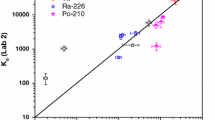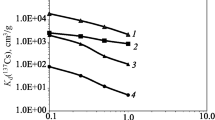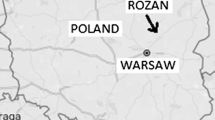Abstract
A study on the potential of geological media from the vicinity of the mining site in Tummalapalle region of Andhra Pradesh in India for retardation of radionuclide migration in groundwater was conducted. The studies included the measurement of sorption coefficients for six radionuclides, uranium, thorium, lead, bismuth, radium and polonium, between two groundwater simulants and two site-specific samples of geological media. Initial parametric studies involving chemical composition, pH, calcium carbonate and organic carbon contents of both geological media and ground water simulants were carried out. Significant differences in sorption coefficients were observed as a result of varying pH, calcium carbonate and presence of trace quantities of organic contents in simulant solutions. For example, uranium has a hundred fold lower distribution coefficient in the case of simulant solution having higher carbonate content. Similarly, in the case of the geological media having higher calcium carbonate and organic carbon contents, higher distribution coefficients were obtained for all radionuclides. Among the six radionuclides studied thorium showed the largest and radium the smallest distribution coefficient values for the soil samples assessed. The site-specific sorption coefficients will be used for contaminant transport study.



Similar content being viewed by others
References
Adams J, Osmond J, Rogers J (1959) The geochemistry of thorium and uranium. In: Ahrens H, Press F, Rankama K, Runcorn SK (eds) Physics and chemistry of the earth. Pergamon Press, NewYork, pp 298–348L
Ames L, Rai D (1978) Radionuclide Interactions with Soil and Rock Media. EPA 520/6-78-007, U.S. Environmental Protection Agency, Las Vegas, Nevada
Butler AP, Wheater H (1999) Modeling radionuclide transport and uptake in an integrated lysimeter experiment: II Application to sodium-22. J Environ Qual 28(6):1946–1956
Butler C, Aguero A, Edlund O, Elert M, Kirchner G, Raskob W, Sheppard M (1999) Performance assessment studies of models for water flow and radionuclide transport in vegetated soils using lysimeter data. J Environ Radioact 42:271–288
Davis P, Avadhanula M, Cancio D, Carboneras P, Coughtrey P, Johansson G, Little R, Smith G, Watkins BM (1999) BIOMOVS II: an international test of the performance of environmental transfer models. J Environ Radioact 42:117–130
Fernandes H, Franklin M, Veiga L, Freitas P, Gomiero L (1996) Management of uranium mill tailing: geochemical processes and radiological risk assessment. J Environ Radioact 30(1):69–95
Hansen W (1970) Polonium-210 in soils and plants. Special Report on U.S. Atomic Energy Commission Contract No. AT(11-1)-1733, COO-1733-11
Harmsen K, Haan F (1980) Occurrence and behaviour of uranium and thorium in soil and water. Neth J Agri Sci 8:40–62
Krizman M, Byrne A, Benedik L (1995) Distribution of 230Th in milling waste from the Zzirovski vrh uranium mine (Slovenia) and its radioecological implications. J Environ Radioact 26:223–235
Langmuir D, Riese A (1985) The thermodynamic properties of radium. Geochim Cosmochim Acta 49:1593–1601
Lieser K, Steinkopff T (1989) Chemistry of radioactive iodine in the hydrosphere and in the geosphere. Radiochim Acta 46:49–55
Lieser K, Ament A, Hill R, Singh R, Stingl U, Thybusch B (1990) Colloids in groundwater and their influence on migration of trace elements and radionuclides. Radiochim Acta 49:83–100
Maity S, Mishra S, Bhalke S, Pandit G, Puranik V, Kushwaha H (2011) Estimation of distribution coefficient of polonium in geological matrices around uranium mining site. J Radio Nucl Chem 290(1):75–79
Mortvedt J (1994) Plant and soil relationships of uranium and thorium decay series radionuclides -a review. J Environ Qual 23:643–650
Ollila K (1985) Dissolution experiments of unirradiated uranium dioxide pellets. Nuclear waste commission of finish power companies. Report YJT-85-02
Paquette J, Lemire R (1981) A description of the chemistry of aqueous solutions of uranium and plutonium to 200°C using potential-pH diagrams. Nucl Sci and Engg 79:26–48
Petterson H, Hancock G, Johnston A, Murray A (1993) Uptake of uranium and thorium series radionuclides by the water lily, Nymphaea violacea. J Environ Radioact 19:85–108
Sheppard M (1980) The environmental behaviour of uranium and thorium. Atomic energy of Canada limited report, AECL-6795
Thiessen K, Thorne M, Maul P, Prohl G, Wheater H (1999) Modelling radionuclide distribution and transport in the environment. Environ Poll 100:151–177
Tome F, Blanco M, Lozano J (2003) Soil-to-plant transfer factors for natural radionuclides and stable elements in a Mediterranean area. J Environ Radioact 65:161–175
Ulrich H, Degueldre C (1993) The sorption of Pb-210, Bi-210, and Po-210 on montmorillonite—a study with emphasis on reversibility aspects and on the effect of the radioactive decay of adsorbed nuclides. Radiochim Acta 62:81–90
U.S.E.P.A (2004) Understanding Variation in Partition Coefficient, K d, Values. vol. III: Review of Geochemistry and Available K d Values for Americium, Arsenic, Curium, Iodine, Neptunium, Radium, and Technetium. Office of Air and Radiation. (EPA-402-R-04-002C):5.66 & 5.68
Vaaramaa K, Lehto J, Ervann H (2003) Soluble and particle-bound 234,238U, 226Ra, and 210Po in ground waters. Radiochim Acta 91:21–27
Acknowledgments
The work is a part of coordinated DAE-BRNS project. The authors thank Dr. T. Mukherjee, Director Chemistry group for his constant encouragement and support in the present work. The authors are grateful to the coordinator Dr. G.G.Pandit and co-coordinator, Dr. Suchismita EAD, BARC for the constant support during the project. The authors are thankful to Dr. R. Verma for his continuous support and many fruitful discussions throughout the work. We wish to acknowledge Dr. Naina Raje, Dr. Sanjukta A. Kumar, Dr. D. N. Wagh, Ms. Nyoti Shenoy, Ms. Avanti Singh, Ms. Ayushi Dudhwadkar and Shri E K Unnikrishnan, ACD, BARC for their cooperation in providing various analytical data. We acknowledge Shri Anil Kumar, RSSD, BARC and Dr. Pramila Sawant, IDD, BARC for providing gross-α measurements.
Author information
Authors and Affiliations
Corresponding author
Rights and permissions
About this article
Cite this article
Dalvi, A.A., Kumar, S.D. & Reddy, A.V.R. A site-specific study on the measurement of sorption coefficients for radionuclides. Int. J. Environ. Sci. Technol. 11, 617–622 (2014). https://doi.org/10.1007/s13762-013-0254-8
Received:
Revised:
Accepted:
Published:
Issue Date:
DOI: https://doi.org/10.1007/s13762-013-0254-8




